








Steve Crutchley - Pilot and Aircraft BuilderBy Brian SpurrGoogle Banner Ad 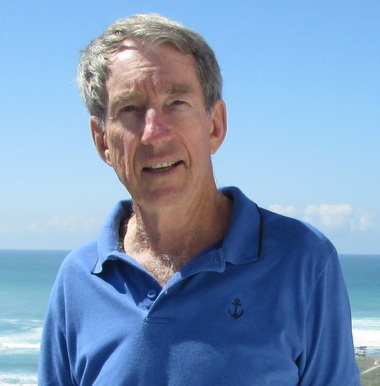 In this article we will get to know Steve a bit better and discover his journey in aviation. Steve now aged 77 is retired and happily living in Plettenberg Bay. Steve grew up in Bedford View in Gauteng but his family moved to Pietermaritzburg, where he went to high school at Maritzburg College. He became interested in aviation through his 18 years older half-brother, Warrant Officer Roy Crutchley, who was in the SAAF in WW2. As a young man (17/18) Roy was an air gunner on Liberators in North Africa and Italy but did not see action as he arrived too late in the war. After the war Steve went to a number of airshows with Roy at Baragwaneth and Rand among others. From this he began an interest in aviation. He did not think he would be able to fly due to the costs. After school he began a mechanical engineering degree at Howard College (Natal University). During the final years of his course he was sent, for a couple of months, to do a practical stint with Pretoria Portland Cement. As it was near Rand Airport, he used to spend his weekends there just observing the action. He got to meet Frank Lister who had just started a small flying school using a Piper J3 Cub. Frank was an Englishman who had been in the air force during the war. Steve decided to begin flight training as he felt he may never have the same opportunity again. The cost of training then was R7.50 per hour! So, over the December / January period of 1963 / 1964 he flew around 12/15 hours in the Cub and went solo during that time. As Steve and his instructor Frank both had day jobs starting at 7am, they used to fly at 6am in the morning before rushing off to work! A sad postscript to his time flying with Frank Lister was that some six months later, Frank was fatally injured in a crash in Umzinto on 12 Jul 1968. Frank had been hired as a demonstration pilot on the Cessna 182 lookalike, the Italian built Pilatus P64B Oscar B1155 (RSA200). He was demonstrating at a farmer's market and unfortunately hit the top of some trees. The aircraft he was flying was ZS-FCH (formerly G-AVND and I-PAKK (thanks for the information, Ray Watts!)). 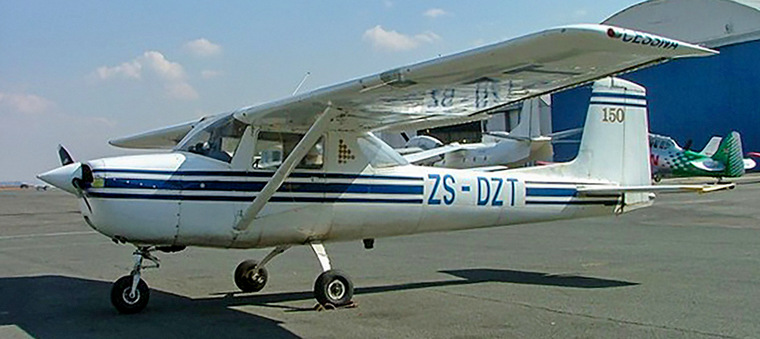 ZS-DZT - One of the Cessna 150's Steve trained in at Virginia Airport Photo by the late Dave Becker. Steve then went back to university in Durban and decided to join Durban Wings Club at Virginia Airport. He recalls training with the well-known instructor Les Miller as well as John Pocock, Brian Upton, Les Smith and D. Hoidge. A couple of registrations he remembers were Cessna 150's ZS-DZT, and ZS-EGM. He completed his PPL around February / March 1966. After that he was called up for national service and he ended up in the SAAF at Valhalla in the technical section. Although he was not flying, he did manage to get some rides in Harvards, Dakotas and Skymasters.  Crutchley Special in flight.  Crutchley Special from EAA Convention Welkom 1976. Photo by Jeff Krause In total the build took him 2200 hours. After many ground runs the first flight was completed on 28 November 1975. The only noticeable problem was a nose down trim and this was rectified by a fixed tab on the elevator. He flew the Special to the EAA Convention in Welkom in April 1976. At that stage the aircraft had 43 hours on the airframe and engine. He flew the aircraft for 25 years and for around 1000 hours. He says he avoided long trips but at a later stage he flew it to Plettenberg Bay and back to Pietermaritzburg without any problems. Steve built the framework entirely in metal as his education made him proficient in the strength and properties of that material. He did not use wood due to the difficulty of assessing the quality and strength of different types of timber. He also said that his aim was to build the simplest design possible, with no fancy parts to ensure structural integrity and reliability.  Crutchley Special in formation Crutchley Special in Margate The Crutchley Special was still on the register until 17 Mar 2003 when the Authority to Fly expired. It is thought that the engine, instruments and radio were sold and the airframe sold as scrap. This is not confirmed. Steve did not see it again after selling it to a person in Margate. The Revmaster engine was temperamental as far as starting was concerned. It was later modified to have a starter motor but this resulted in extra weight, something that Steve had sought to minimise. It was involved in a couple of incidents after it had been sold. It once had a forced landing on the beach after losing power and another time hitting rocks on the extended centre line for the same reason. Several owners bought the aircraft, one of whom decided to add dihedral to the wings, when rebuilding after one of the incidents. This involved cutting the one-piece main spar and a joint apparently failed during load testing on the ground. This ended the life of a unique little aeroplane. The Vagabond parked at a small village near the Swaziland border. Swinging the prop Steve and BZG 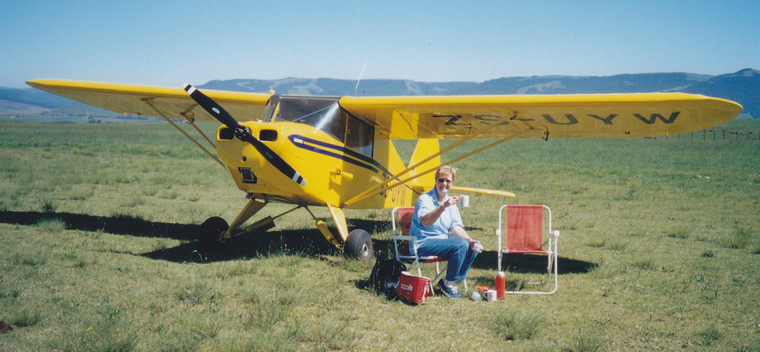 The Vagabond with new colours and registration. Photo by the late Dave Becker After university Steve returned to Pietermaritzburg and joined the Pietermaritzburg Aero Club. He later became chairman of the club for a period. He later became involved with the EAA and became Hon. Secretary of Chapter 357 in 1976. After a year or two of flying club aircraft, he became involved with a syndicate of five enthusiasts who bought a Vagabond (ZS-BZG) in 1971. The Vagabond was purchased from Bob Wright in Empangeni for R1300! They flew it and had fun for three years. On one trip Steve flew to friends on the Swaziland border and damaged the tail wheel when landing in a rough field. He managed to fix it and flew out using the road as it had a much better surface. Later they were informed that the airframe would need to be recovered to obtain an airworthiness certificate. The cost of the recovering was high so it was decided that they would sell the aircraft. Thirty years later Steve managed to buy it back and it was then registered as ZS-UYW! 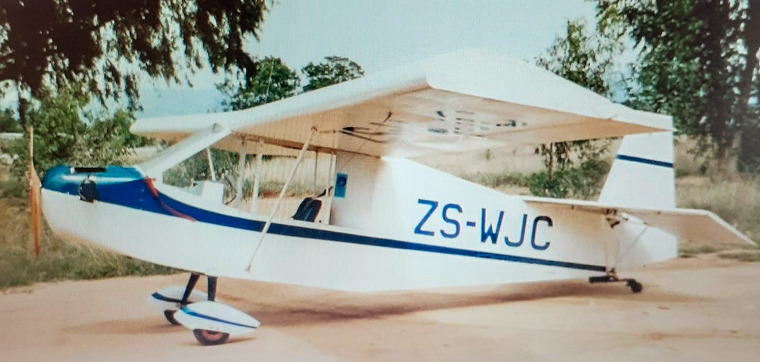 The Cloud Buggy Photo by the late Dave Becker 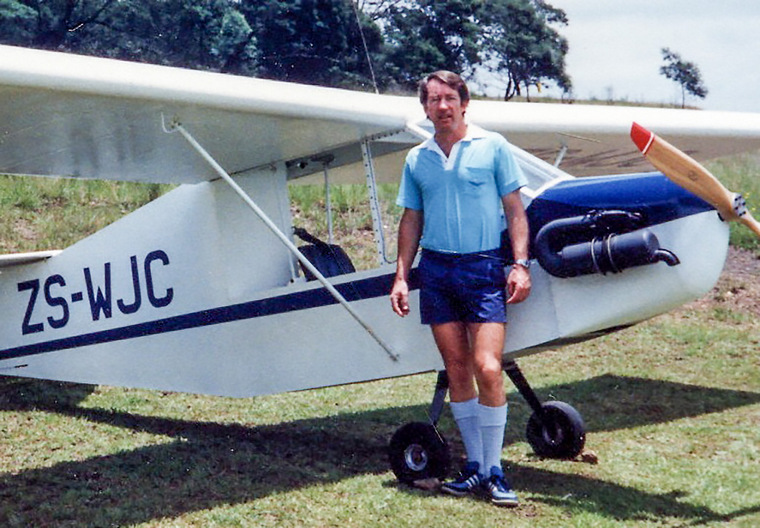 Steve with the Cloud Buggy Sometime later he was looking for a project. He had always had a home workshop and he wanted a J3 Cub but could not afford one. So, he decided to build an ultralight aircraft. This became known as the Cloud Buggy. This build took some time but when complete took the registration ZS-WJC. The build took place over nearly a decade as he could only work on it when he had time in between many other projects such as building a hangar, a house and flying the Special! He did not keep a record of the hours he spent working on the Buggy. It had a Rotax engine. Steve flew the first flight at Oribi on the 14th of January 1990. It was of 45 minutes duration. Having two other aircraft, he only did 128 hours in the Buggy before selling it. He said that they were some of the most enjoyable hours of flying he did in his 40 years of holding his PPL. Steve's last flight in it was on the 24th of November 1996. Steve sold it to John Le Roux for R12, 000. This is the very same aircraft that is under restoration at St. Declan's Academy. Steve says he regrets selling it. 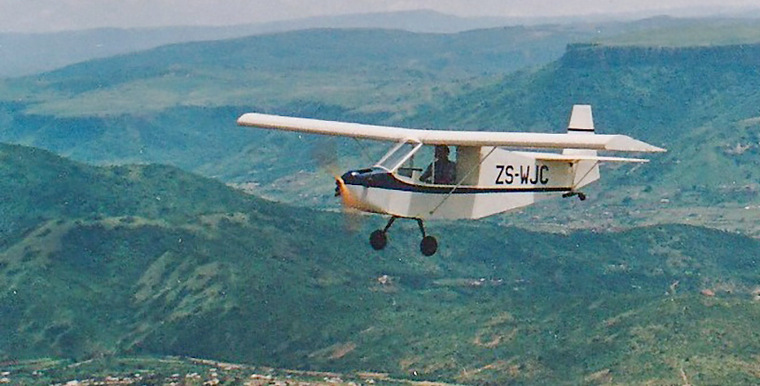 Cloud Buggy in flight in the Table Mountain area of Pietermaritzburg 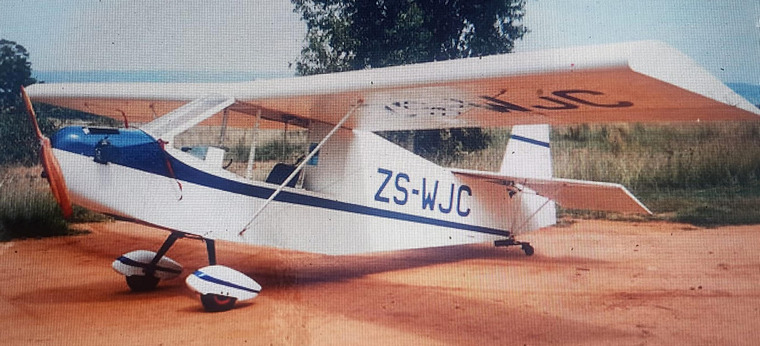 Cloud Buggy. Photo Bruce Perkins When he retired to Plettenberg Bay some 15 years ago there was little happening down there, aviation wise. For him to purchase a hangar at that time would have cost R450,000. As there was little infrastructure (unlike now) so he decided to sell his aircraft and he has not flown since. He said if South Africa had allowed FAR part 103 operations, as in the United States, he would have been keen to continue flying. FAR Part 103 allows very unrestricted flying of ultralight home built single seater aircraft. All in all, he had an interesting aviation journey. He told me that he enjoyed the engineering side as much as he did the flying. Designing and building two unique South African aircraft and his involvement in his club and the EAA make him a pioneering aviator. We trust he will continue to enjoy his retirement and enjoy watching the progress of the rebuild of his Cloud Buggy. Google Banner Ad 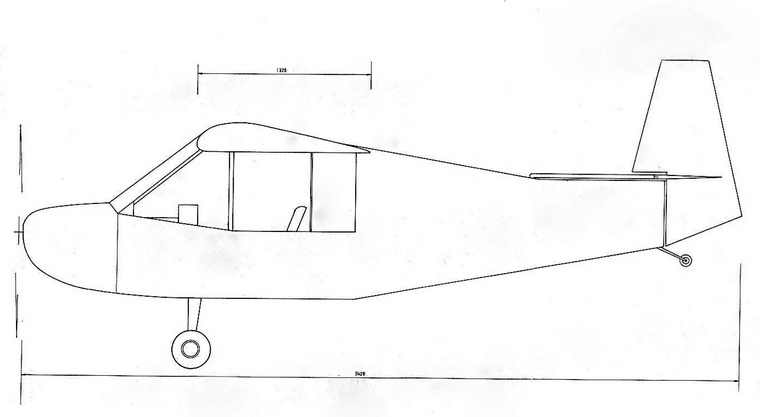 CLOUD BUGGY - ZS - WJC General Note It is important to understand that this aircraft was designed, built and tested by an amateur. Because of the very light construction it should never be operated at a mass exceeding the placarded gross mass of 265kg, nor flown at a speed greater that the never-exceed speed of 60 knots. The pay load including pilot fuel and baggage is 100kg. Because of the light construction and low wing loading it should not be flown in gusty or turbulent conditions Fuel System The fuel tap is "on" when the handle is along the fore and aft axis of the aircraft and "off" when it is at ninety degrees to this axis. The design capacity of the tank is 30 litres but it will take nearly 40 litres if filled to the overflow. This condition should be avoided. Engine Starting Unless the engine is warm from a previous flight it will be necessary to use the choke on the carburettor. Starting is carried out by swinging the propeller. In-flight starts or starts when warm can be done using the pull-cord in the cockpit. Brakes The brakes work well once one is used to the foot-work required to steer and apply brakes simultaneously. A modification to toe-brakes would be a great improvement. Take-off Lift the tail as soon as possible, lift off at 35 knots, fly briefly in ground effect until 40 knots is reached and then climb at 40 knots. There is very little momentum and lots of drag in the nose-high attitude. Be ready to instantly lower the nose should the engine lose power. Google Block Ad Cruise Level off and reduce revs to about 5 200 rpm. At Oribi elevation this gives an I.A.S. of about 45 knots. Glide The glide is comfortable at 40 knots. It side-slips easily if required on approach. Landing Because of the lack of momentum and the high drag do not flare out too high. Maintain 40 knots until only a few feet above the ground. Hold off at about one foot until even at full aft stick will not keep it in the air. The landings are generally straight forward but avoid cross-winds and gusty conditions. The undercarriage mounting and small wheels are not suitable for rough fields. Use only surfaced runways or very smooth grass.  Google Banner Ad PLEASE GO TO www.youtube.com/channel/UCCuRVZAGodT6sztTeXBGeMw and subscribe to our YouTube channel |
               |
 |
 |

Copyright © Pilot's Post PTY Ltd
The information, views and opinions by the authors contributing to Pilot's Post are not necessarily those of the editor or other writers at Pilot's Post.